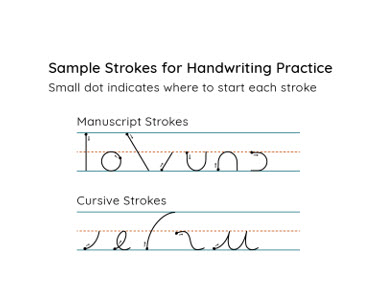
What If My Kid Hates Writing Part 1
October 11, 2022Part 1 of a 3-part series on handwriting. Guest post by HollyonHandwriting
If a student is ever to enjoy the writing process, getting words on paper must be easy and automatic. If it is not, their working memory that would otherwise be used to formulate ideas and order thoughts will be tied up with the act of getting the letters and words down on paper. This is like trying to drive sixty miles per hour with speed bumps in the road. Bump after bump prevents the student from ever getting up to speed with their writing. This can, understandably, result in headaches and frustration.
To be able to express oneself, communicate ideas, and problem-solve are broad reasons why being able to write effectively matters. But if they hate writing? How can they learn to write if we can’t get them to practice? Getting our thoughts out of our heads and onto paper (or into a computer) is a vital skill, especially in our digitally interconnected world, so it is important we consider the possible problems in order to effectively help our students.
In this three-part series, I will present three broad learning areas to consider when helping your child develop the necessary foundation for writing success. In this first article, we consider transcription.
Writing is a complex task. It involves layer upon layer of skill and knowledge, and it takes many years to learn how to write well. To figure out why writing pains your student, you can begin looking at the foundational layers of writing to search for problem spots. (Parents and guardians should always seek professional help for any medical or behavioral concerns that go beyond these basic learning difficulties.)
Possible Problem: The Physical Act of Transcribing
As you try to understand why your student “hates” writing, I’d like to suggest you first look at your child’s ability to transcribe their thoughts. Transcribing is the act of getting the message from one’s head out into the written world—making the invisible visible, so to speak. Transcribing, then, requires being able to either handwrite or type.
For many students, this physical act is a pain point. In my experience, this very basic foundational skill is almost always overlooked as a possible cause of writing trouble, especially in kids beyond first grade. Without the ability to fluently write, students struggle to do written assignments.
If we look broadly at the means of getting thoughts onto paper, students either use a writing implement such as a pencil or pen, or a keyboard. (Producing writing by “texting” is not considered here.) Children learn to grasp and manipulate a writing implement at a very young age. Around the age of five years, they begin forming letters and numbers.
How they learn to form these symbols will affect their writing fluency as their minds and motor skills develop. (Here, I specifically address writing by hand, though formal keyboarding skills should also be taught to students over eight so that typing becomes automatic.) If your child was not explicitly taught how to form letters efficiently, their struggle may originate here.
Forming Letters and Numbers
To help prevent this potential writing ailment, we should systematically teach and guide our young learners to form letters and numbers correctly. This goes beyond presenting the student with a workbook and requiring them to “practice making letters.” Young children do not intuitively understand the printed instructional conventions that make sense to adults.
For example, they do not always understand that the arrows, commonly provided next to the letter, indicate the direction to write; if they are learning to read, they often do not understand that the picture on the page represents a word that begins with the letter they are practicing; they may not know where to start and end the letter or how to pick up or NOT pick up the pencil.
None of this comes naturally to young students. You can be their coach. Even after providing initial instruction, they will need ongoing guidance as there is a strong tendency for a child to revert to instinctual movements that hinder writing fluidity (i.e., bottom-to-top or clockwise gestures).
Handwriting Rehab
How to treat and rehabilitate a student with writing struggles depends on several factors, including the child’s age and the extent of the problem. For students under the age of seven, I recommend going back to the basic building blocks of letter formation. (Squiggle Squad handwriting resources provide an enjoyable stroke-by-stroke approach to correct, efficient letter formation.)
In the early stages, it is important that the focus be on directionality, size, and eventually speed, rather than on the look of the final product. Legibility should not be overlooked, of course, but motor control and precision will improve this over time, so in the initial stages pay close attention to the process of forming each letter.
If your struggling writer is over the age of seven, re-teach correct letter formation and plan daily practice that involves repetitive movements to improve coordination and fluidity. Remember, handwriting is first and foremost a motor skill, so other activities that require hand, arm, and finger movements will also improve the stamina and coordination needed for writing. Some ideas:
- Dot-to-dot activities. These activities require the child to find an endpoint first with their eyes and then meet that point with their pencil. This improves eye-hand coordination and pencil control. There are some wonderfully creative dot-to-dot activities found online or in books that kids of all ages (even adults!) enjoy.
- Coloring books. By giving kids boundaries, coloring pages help improve focus and precision with a writing implement. I recommend that kids use colored pencils. Check that their pencil grip is correct to reinforce the crossover writing skills. When they’re ready, challenge your child to try more difficult coloring activities.
- Single strokes on paper with guidelines. Choose a single handwriting stroke, and have the student repeat it across the page. (See example below.) Have them try as slowly as necessary to stay within the guidelines, then gradually speed up. This repetition secures the movement in their muscle memory making it easy and fluid.

Cursive writing requires a fluid motion that allows for a comfortable flow of arm and hand, producing a legible script that kids often take pride in. It may also provide an opportunity to break poor writing habits that have formed in your child’s muscle memory. Cursive writing could be that new approach that helps your child get back on track for writing success.
Again, the end goal of handwriting instruction is to help the child develop a means of getting their thoughts on paper with ease so that they can move on to the more complicated aspects of writing such as content, syntax, and expression.
When students are first learning to write, reduce the number of cognitive tasks required so that the student can focus on the physical act of writing. Once the act of writing becomes easier for them, then you can begin adding more writing expectations— this progression will yield much better success in both the student’s quality of writing and enjoyment for the writer.
More about the Author Holly Britton. The Squiggle Squad’s program designer, Holly Britton, M.Ed., is a curriculum and instruction specialist with teaching experience in all grades K-8. She is an author and conference speaker and a former home educator of four now-adult children. Holly brings over 22 years of private and public education experience to this program. Holly relishes time with her friends and family including her horse, Shasta.
More Articles on Homeschool Handwriting
Handwriting: An Indespensible Learning Tool
Teaching and Improving Handwriting Skills
How and Why We Teach Cursive Handwriting
Why Your Teens Should Know Cursive Writing
Latest Posts

While nearly every college and university today is eager to accept homeschooled students into their institutions, homeschooling families need to understand that their student’s application…
Read more >
Guest Post by Gabriel Morse For several years, I sat for long hours every day behind one of those battleship gray desks in a windowless, dull, gray office. The pay was enough to take care…
Read more >
This post is sponsored by Little Monsters Universe. I'm Tina Salmanowitz, an advocate for homeschooling and science education. With over a decade of experience as a science educator (in class…
Read more >


